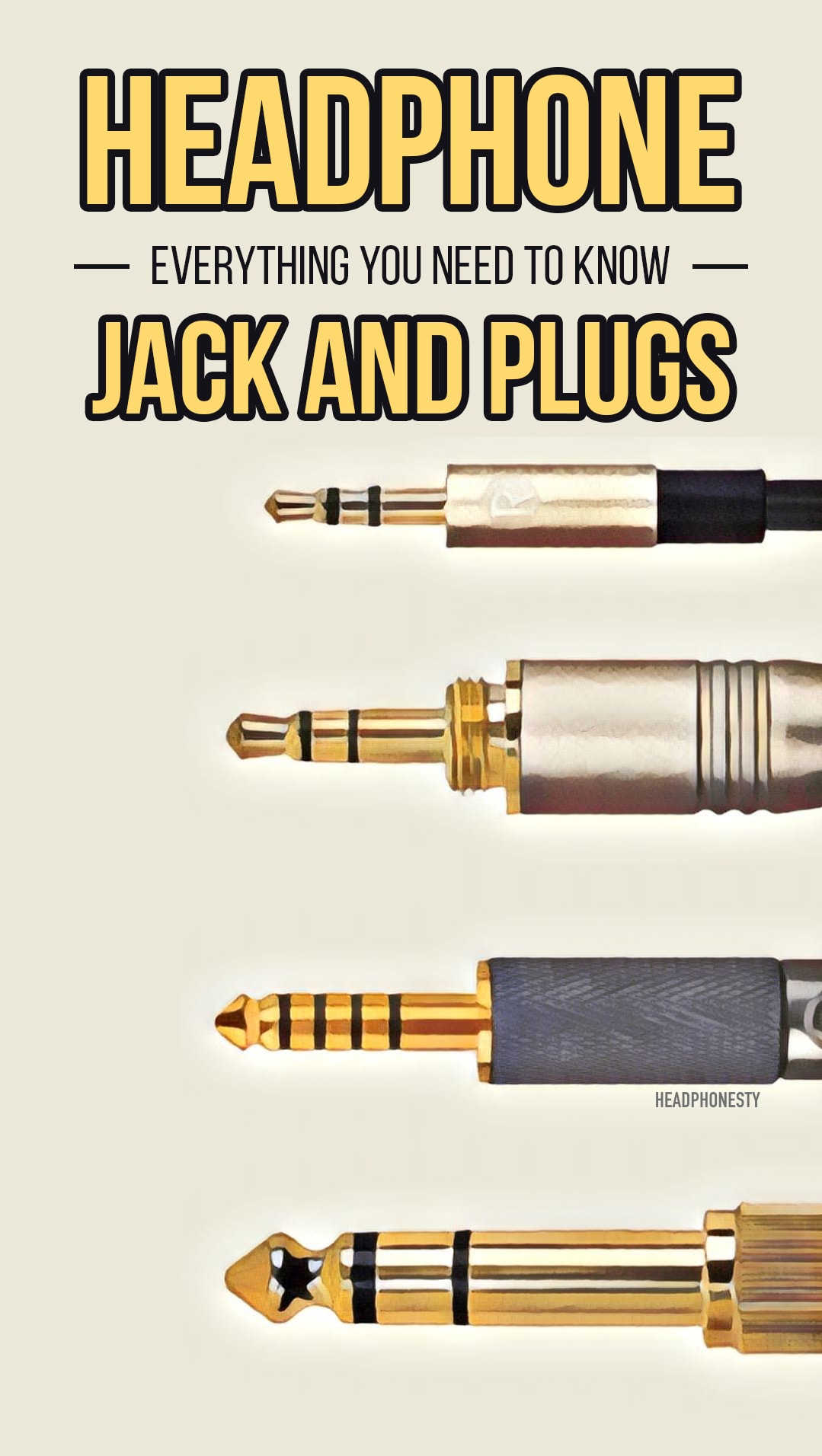What Size is a Headphone Jack? Headphone jacks are fixed ports that allow audio signals to be transmitted between headphones and devices. Headphone plugs are the male connectors at the cord's end, whereas the jack is the female receiving end. Headphone jacks and plugs come in a variety of sizes.

Headphone plugs frequently have cylindrical pin ends, whereas jacks are round, hollow sockets. Different devices have different jacks and plugs for higher quality audio, and you must become familiar with the terminology to determine which plugs you require or whether an adapter is required.
Headphone jacks are frequently installed on devices and cannot be easily replaced. As a result, users must determine which plugs to use with the jack ports. There are numerous types and sizes of plugs and jacks with various names.
With this guide, I'll try to help you understand them all, as well as which types and sizes you'll need for your gear.
Key takeaway
3.5 millimeters is the standard headphone jack size (mm). 2.5mm and 6.35mm are also used, with the latter being more popular in professional audio equipment.
The Four Most Common Headphone Jack and Plug Sizes
2.5 mm
3.5 mm
4.4 mm
6.35 mm
What Is the Difference Between a Headphone Jack and a Headphone Plug?
Headphone jacks and plugs are two of the most commonly misunderstood terms in the music industry. Headphone plugs are the male ends of headphone cords, whereas headphone jacks are the female ports installed on the devices. However, the term ‘jack' is used for both male and female ends, which causes confusion.
To avoid confusion and to be precise about the different parts, I will refer to the ports as jacks and the male connectors as plugs in the article.
The Four Kinds of Headphone Plugs
There are four types of headphone plugs that are commonly used on various devices. The names of the plug types indicate the number of conductors in the plug. T stands for tip, R stands for ring, and S stands for sleeve.
Connectors TS
The TS (Tip-Sleeve) type of connector, which has two conductors, is the most basic type of headphone plug. The sleeve serves as a ground, and the tip is in charge of audio signal transmission.
TS connectors can only transmit mono audio signals and are best suited for short cables. They may experience audio distortion with long cables. They are typically 2.5 mm in diameter and are used for instrument-amp or headphone connections.
Only unbalanced mono audio signals can be transmitted by TS jacks and plugs. One section is in charge of audio signals, while the other serves as a ground and return wire.
Connectors TRS
TRS connectors (Tip-Ring-Sleeve) have three conductors. With the addition of the ring, the audio signal can be balanced mono or unbalanced stereo. This means that these headphones can be used for stereo sound without a microphone or mono sound with a microphone signal.
This is one of the most common types of headphone plugs found on most headphones. These plugs can carry microphone signals, also known as unbalanced audio signals, by adding another conductor.
The tip and ring of a balanced mono system are responsible for the negative and positive signals, respectively, while the sleeve serves as the return wire. In an unbalanced system, the tip handles left channel signals, the ring handles right channel signals, and the sleeve handles ground return.
Connectors for TRRS
TRRS (Tip-Ring-Ring-Sleeve) connectors have four conductors. These connectors support unbalanced stereo audio as well as a microphone signal at the same time. They meet the Cellular Telecommunications and Internet Association standards (CTIA).
TRRS connectors are commonly found in computers, smartphones, and gaming consoles. They provide users with stereo sound via the microphone signal. The tip, two rings, and sleeve are in charge of right and left channel audio signals, as well as the ground return path, while the sleeve is the microphone signal wire.
Alternative Video: Difference between 2.5 mm and 3.5 mm Headphone Jacks
SUGGESTED POSTS:
- What You Need To Know About Subwoofer Size For Room? [Easy Guide]
- What Is The Difference Between 2 Ohm Vs 4 Ohm Speakers? (Answered!)
- What You Should Know About Subwoofer Size Chart? [Ultimate Guide]
Connectors for TRRRS
TRRRS (Tip-Ring-Ring-Ring-Sleeve) connectors are the last type of common headphone plug. These headphone plugs, which have 5 conductors, are used in professional music production gear because they support balanced stereo signals.
TRRRS is used in professional audio systems because it has two balanced channels with double left and right channels to produce a proportional stereo signal with greater clarity.
The tip and first ring serve as the left channel, with positive and negative polarity. The second and third rings serve as the right channel, with positive and negative polarity, respectively, while the sleeve serves as the ground wire.
The Four Most Common Headphone Jack and Plug Sizes

There are four common sizes of headphone plugs: 2.5 mm, 3.5 mm, 4.4 mm, and 6.35 mm. They are all used for various audio applications and can be of various types. When discussing headphone jack sizes, the outside diameter of the sleeve conductor is considered.
2.5 mm
The smallest headphone jack/plug size is 2.5 mm, also known as a micro jack. They are TS-style plugs that only transmit audio. They are mostly used with mono headphones for video cameras and, on rare occasions, with mobile phones.
This is a very uncommon headphone plug/jack size because it was used for smartphones, but the standard did not hold and manufacturers began using mini jacks instead.
3.5 mm
The most common size for headphones is 3.5 mm headphone jacks/plugs. TRS and TRRS style systems, which are preferred by many laptops, smartphones, portable audio players, and tablets, use 3.5 mm jacks and plugs.
4.4 mm
4.4 mm headphone plugs are new and scarce. Sony's Pentacon plugs and jacks, which are designed for balanced stereo audio signals, prefer them. Pentacon plugs are TRRRS-style plugs with 5 conductors that produce audiophile-quality sound.
6.35 mm
The largest known jack/plug size is 6.35 mm, which is more commonly used for instruments than headphones. However, this size headphone plug is used by some headphone amplifiers and audiophile-quality headphones.
The first headphone plug size used with vintage audio equipment was 6.35 mm jacks and plugs. They are now primarily used for professional audio equipment. There are various styles that use mono or stereo sound.
The mono sound models are used for musical instruments such as guitars and synthesizers, while the stereo plugs are used for headphones.

Other Headphone Jack Types
There are three other types of headphone jacks to mention: Audio Lightning Jack, USB Jack, and USB-C Type Jack.
Lightning Audio Jack
In 2012, Apple introduced audio lightning jacks, which gradually replaced 3.5 mm headphone jacks on Apple iPhones. Beginning with the iPhone 7, all models are equipped with audio lightning jacks for audio transmission.
They have built-in digital-to-audio converters, which allow for audio transmission without distortion or compression, so the sound quality is significantly improved. It also allows for more features because the device can be charged via the lightning port, and the port can be used for a variety of purposes requiring any type of digital input.
USB Port
USB ports are primarily used for gaming on laptops and PCs. They are intended for eSports players' gaming headsets because this type of connection produces clear and resonant sound. This is due to the fact that USB jack headsets frequently include an amplifier.
USB Jack headsets use far more power than traditional headphones. It is not a problem if you use them with computers, but otherwise, they can quickly drain your battery.

Type C USB Jack
USB C-Type jacks have been around for a while, mostly used by smartphone manufacturers such as Samsung, Huawei, Xiaomi, and Google. Similar to how Apple switched to lightning jacks for audio transmission to improve sound quality, other brands began using USB-C for the same purpose.
Adapters
Adapters are required to use different plugs with different sizes or types of jacks. To successfully connect incompatible plugs and jacks, adapters act as a bridge.
The 3.5 mm to 6.35 mm jack adapter is the most commonly used adapter for connecting headphones to amplifiers. The audio lightning jack to 3.5 mm jack adapter is another popular adapter that allows users to connect standard headphones to iPhones and iPads.
There are many different adapters available today that can connect almost any headphone plug to almost any headphone jack.
The Composition of a Headphone Plug
A headphone plug's structure is made up of conductors, which are tips, sleeves, and rings, as well as insulating bands.
The conductors are the points at which the electrical circuit between the plugs and jacks is completed. Every plug has at least two and up to five conductors. Tips, sleeves, and rings make up the conductors.
The tips, as the name implies, are the ends of the plugs. The sleeves are the back part of the plugs that determine the diameter. The rings are the middle sections that connect the sleeves and tips.
The tips and sleeve of each plug have at least two conductors. Every conductor is separated by a black band known as the insulating band. The ring count of a plug determines its name, such as TS, TRS, TRRS, and TRRRS plugs.
Signals and audio
There are two types of audio signals that can be transmitted between headphones and audio sources: monaural (mono) and stereophonic (stereo). Mono audio only has one channel, whereas stereo audio has two separate channels labeled left and right.
While mono signals reproduce audio from only one position, stereo signals are created by two different channels, resulting in a method of audio reproduction that is more similar to the natural hearing experience.
This is an important consideration in headphones because certain types of jacks and plugs support stereo audio signals, which you should look for in a good pair.
Another distinction to make is between balanced and unbalanced audio. This topic can be overwhelming and confusing, so I'll do my best to summarize it. The majority of headphones use unbalanced audio signals, with a few exceptions.
A balanced audio system has two signal wires, one positive and one negative. Unbalanced audio means that there is only one signal wire and one ground/return wire.
Unbalanced mono, balanced mono, unbalanced stereo, and balanced stereo are the four types of audio signals. Unbalanced mono requires at least two conductors; balanced mono and unbalanced stereo require at least three conductors; and balanced stereo requires at least five conductors.
Conclusion
Headphone jacks and plugs come in a variety of styles and sizes, which can be confusing for users who are unfamiliar with the terms and signal types. However, once you understand the fundamentals, you will be able to easily understand how audio is transmitted between the headphones and the audio source.
This way, you can determine which audio signal is best for you and whether or not your equipment requires an adapter. You can also know which headphones to use for which purposes and take into account the conductor count and jack size when shopping for new headphones to get the best sonic experience possible.
Watch this: 5 Types of Audio Jack We Use in Daily Life
FAQs What Size is a Headphone Jack
What is the normal headphone jack size?
The 6.3 mm headphone jack is an older standard that is more commonly found in professional audio equipment.
What uses a 2.5 mm jack?
The smaller 2.5 mm size is more commonly used to connect headsets to devices such as landlines, lightweight two-way radios, and video cameras. Those require a microphone as well as audio, which is why there is sometimes an extra stripe.
Are 1/8 and 3.5 mm jacks the same?
Yes, aux connectors and headphones jacks are typically the same size (3.5mm or 1/8-inch TRS). As a result, you can plug a 3.5mm jack into anything that has a standard headphone jack.
Recent Content
Canon PowerShot ELPH 360 Digital Camera Review: A Budget-Friendly Point-and-Shoot Option
The Canon PowerShot ELPH 360 HS is a compact and user-friendly digital camera designed for beginners and casual photographers. With its 20.2 MP CMOS sensor, 12x Optical Zoom, and 25x ZoomPlus, this...
Olympus Tough TG-6 Digital Camera Review: A Rugged Companion for Your Adventures
The Olympus Tough TG-6 is a compact, rugged camera designed for capturing stunning images and videos in challenging environments. With its impressive array of features, it is an excellent choice for...


